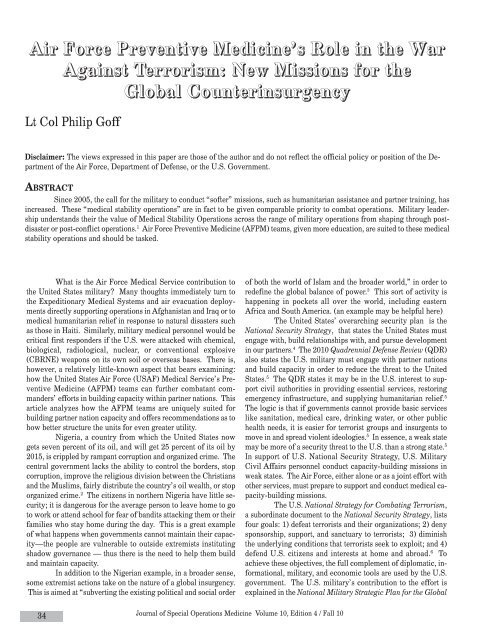Fall - United States Special Operations Command
Fall - United States Special Operations Command
Fall - United States Special Operations Command
You also want an ePaper? Increase the reach of your titles
YUMPU automatically turns print PDFs into web optimized ePapers that Google loves.
Air Force Preventive Medicine’s Role in the War<br />
Against Terrorism: New Missions for the<br />
Global Counterinsurgency<br />
Lt Col Philip Goff<br />
Disclaimer: The views expressed in this paper are those of the author and do not reflect the official policy or position of the Department<br />
of the Air Force, Department of Defense, or the U.S. Government.<br />
ABSTRACT<br />
Since 2005, the call for the military to conduct “softer” missions, such as humanitarian assistance and partner training, has<br />
increased. These “medical stability operations” are in fact to be given comparable priority to combat operations. Military leadership<br />
understands their the value of Medical Stability <strong>Operations</strong> across the range of military operations from shaping through postdisaster<br />
or post-conflict operations. 1 Air Force Preventive Medicine (AFPM) teams, given more education, are suited to these medical<br />
stability operations and should be tasked.<br />
What is the Air Force Medical Service contribution to<br />
the <strong>United</strong> <strong>States</strong> military? Many thoughts immediately turn to<br />
the Expeditionary Medical Systems and air evacuation deployments<br />
directly supporting operations in Afghanistan and Iraq or to<br />
medical humanitarian relief in response to natural disasters such<br />
as those in Haiti. Similarly, military medical personnel would be<br />
critical first responders if the U.S. were attacked with chemical,<br />
biological, radiological, nuclear, or conventional explosive<br />
(CBRNE) weapons on its own soil or overseas bases. There is,<br />
however, a relatively little-known aspect that bears examining:<br />
how the <strong>United</strong> <strong>States</strong> Air Force (USAF) Medical Service’s Preventive<br />
Medicine (AFPM) teams can further combatant commanders’<br />
efforts in building capacity within partner nations. This<br />
article analyzes how the AFPM teams are uniquely suited for<br />
building partner nation capacity and offers recommendations as to<br />
how better structure the units for even greater utility.<br />
Nigeria, a country from which the <strong>United</strong> <strong>States</strong> now<br />
gets seven percent of its oil, and will get 25 percent of its oil by<br />
2015, is crippled by rampant corruption and organized crime. The<br />
central government lacks the ability to control the borders, stop<br />
corruption, improve the religious division between the Christians<br />
and the Muslims, fairly distribute the country’s oil wealth, or stop<br />
organized crime. 2 The citizens in northern Nigeria have little security;<br />
it is dangerous for the average person to leave home to go<br />
to work or attend school for fear of bandits attacking them or their<br />
families who stay home during the day. This is a great example<br />
of what happens when governments cannot maintain their capacity—the<br />
people are vulnerable to outside extremists instituting<br />
shadow governance — thus there is the need to help them build<br />
and maintain capacity.<br />
In addition to the Nigerian example, in a broader sense,<br />
some extremist actions take on the nature of a global insurgency.<br />
This is aimed at “subverting the existing political and social order<br />
34<br />
Journal of <strong>Special</strong> <strong>Operations</strong> Medicine Volume 10, Edition 4 / <strong>Fall</strong> 10<br />
of both the world of Islam and the broader world,” in order to<br />
redefine the global balance of power. 3 This sort of activity is<br />
happening in pockets all over the world, including eastern<br />
Africa and South America. (an example may be helpful here)<br />
The <strong>United</strong> <strong>States</strong>’ overarching security plan is the<br />
National Security Strategy, that states the <strong>United</strong> <strong>States</strong> must<br />
engage with, build relationships with, and pursue development<br />
in our partners. 4 The 2010 Quadrennial Defense Review (QDR)<br />
also states the U.S. military must engage with partner nations<br />
and build capacity in order to reduce the threat to the <strong>United</strong><br />
<strong>States</strong>. 5 The QDR states it may be in the U.S. interest to support<br />
civil authorities in providing essential services, restoring<br />
emergency infrastructure, and supplying humanitarian relief. 5<br />
The logic is that if governments cannot provide basic services<br />
like sanitation, medical care, drinking water, or other public<br />
health needs, it is easier for terrorist groups and insurgents to<br />
move in and spread violent ideologies. 5 In essence, a weak state<br />
may be more of a security threat to the U.S. than a strong state. 5<br />
In support of U.S. National Security Strategy, U.S. Military<br />
Civil Affairs personnel conduct capacity-building missions in<br />
weak states. The Air Force, either alone or as a joint effort with<br />
other services, must prepare to support and conduct medical capacity-building<br />
missions.<br />
The U.S. National Strategy for Combating Terrorism,<br />
a subordinate document to the National Security Strategy, lists<br />
four goals: 1) defeat terrorists and their organizations; 2) deny<br />
sponsorship, support, and sanctuary to terrorists; 3) diminish<br />
the underlying conditions that terrorists seek to exploit; and 4)<br />
defend U.S. citizens and interests at home and abroad. 6 To<br />
achieve these objectives, the full complement of diplomatic, informational,<br />
military, and economic tools are used by the U.S.<br />
government. The U.S. military’s contribution to the effort is<br />
explained in the National Military Strategic Plan for the Global

















